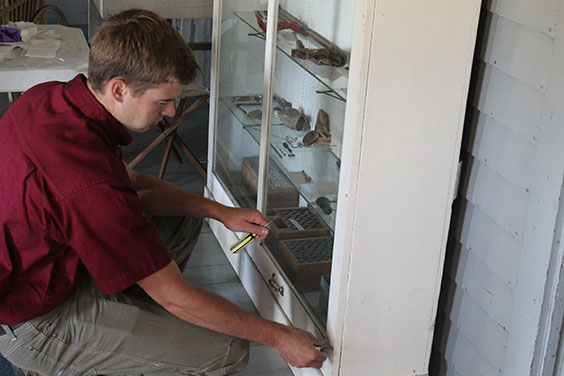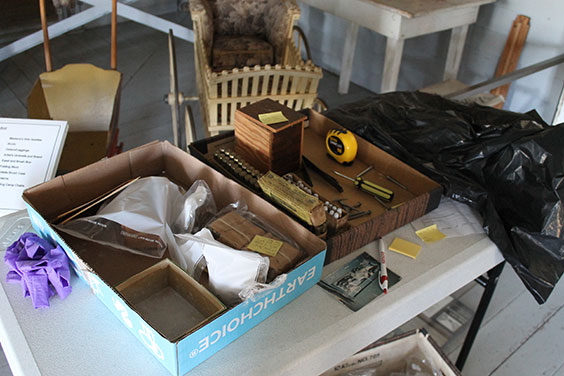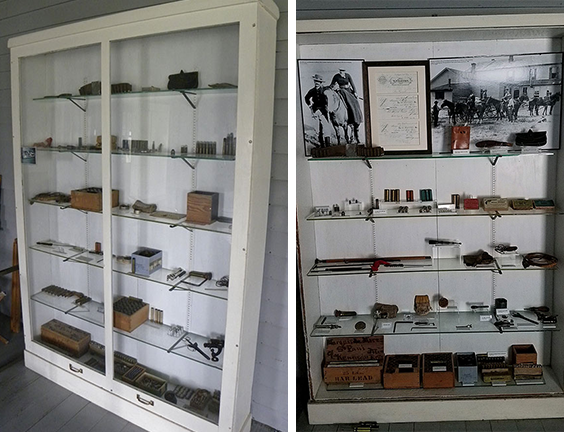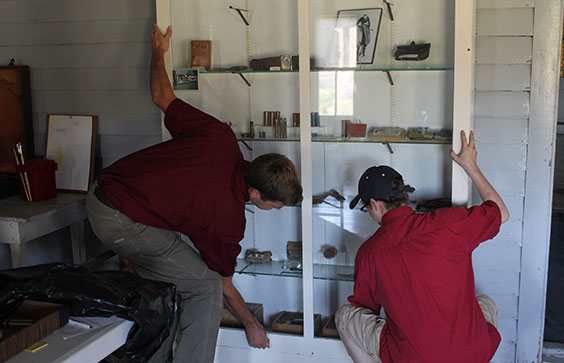Last summer the Chateau de Mores State Historic Site had the pleasure of welcoming Quinn Rick from Dordt College (Sioux Center, Iowa) as an intern. As part of this internship, Quinn’s supervising professor, Dr. Paul Fessler, made a trip to Medora to check in on him. Our work with Quinn impressed Dr. Fessler, and he told Quinn that not many interns are so lucky. Our success with Quinn has to do with my philosophy on what an internship is. It is a pretty simple philosophy: an internship is a learning experience.

Chateau Intern Quinn Rick working on ammunitions exhibit case.
It is all too common for companies or organizations to look at an intern as free labor or grunt labor. Interns fetch coffee and tackle the tasks that nobody else wants—the idea of “paying one’s dues.” The truth is that internships are about learning how to do a job. My background is in education. To me, my time student teaching was my internship. One of the best things that my cooperating teacher ever did for me was to hand the reins of the class over to me. I had done observation with him, and he wanted me to have the experience of teaching the class. On the first day, he introduced himself and then turned the class over to me. For the next 16 weeks, I was the teacher. I will always credit this experience with my classroom success.
I wanted to give Quinn that same experience. I tried to train him to take my job.1 My job does not require me to fetch coffee for anyone, so I was not going to ask him to fetch coffee. I do clean the bathrooms and take out the trash in Chimney Park, and Quinn got to spend some time working with me on that. As we schlepped bags of refuse to the dumpster, I told Quinn that this was my site. How it looks and how visitors experience it is on me.

Quinn's work table
But unlike my cooperating teacher, I could not just throw Quinn the keys and say, “It’s your site now, I will be back in September for it.” There are some things that he was not ready to handle on his own, but I did not shy away from teaching him these tasks. Instead of having him fill out the daily deposits and purchase orders, I went through them with him. I included him in meaningful conversations about site management and had him sit in on meetings. He went with me to a city council meeting and talked to me about how we handle all the difficult parts of the job.
I have always been a jack-of-all-trades, and it means that I do a little bit of everything around the site. For that reason, Quinn did too. He gave tours of the Chateau, helped with inventory in the store, covered lunch breaks, and worked on other projects. Quinn helped with public relations and helped with the creation of Augmented Reality experiences in the gallery. He got to see other sites like the Former Governors’ Mansion State Historic Site, the North Dakota Heritage Center & State Museum, and the Billings County Museum. At each of these places, he got to talk to the folks who work there. They discussed the challenges facing their sites and the work that they do to overcome them.

Ammunitions exhibit case at the start of the season (left) and end of the project (right)
We wanted Quinn to leave here with an experience that he could put on his resume that was truly impressive. His big assignment was the reorganization of an ammunitions exhibit case that we have not opened in decades. He had to catalog the items, document his process, make decisions on what steps he needed to take to update the exhibit, and write up artifact labels. For this project, we also sent Quinn to Bismarck to work with Jenny Yearous, State Historical Society curator of collections. She taught him about various preservation techniques and how to handle artifacts properly. He worked with Genia Hesser, curator of exhibits, on solutions for making the case better. Quinn identified and organized the artifacts in the cabinet by category, removed excess artifacts, and created a list of needed labels to be printed. After putting his new skills to use, Quinn made the exhibit case look great, and we are proud of all his hard work.

Quinn and Interpreter Jesse Whumaker work together to open the ammunitions exhibit case
In the ten weeks that Quinn was with us, we threw a lot of stuff at him, and he handled it well. He was a valuable member of our team last summer. As our site moves forward, I hope to see us offer more internship opportunities. There are many projects that the staff and I want to get done out here. We are continually striving to have the best site. We have some pretty ambitious goals, and they are going to create some great opportunities for future interns. If you or someone you know is interested in interning at the Chateau de Mores, feel free to contact me at cdorfschmidt@nd.gov for more information.
1 This post was written when Chris Dorfschmidt was Site Supervisor at the Chateau de Mores State Historic Site. On April 1, 2019, Chris became a Historic Sites Regional Manager for the State Historical Society. He currently oversees staff and operations at the Chateau de Mores State Historic Site, as well as various other sites across North Dakota.

